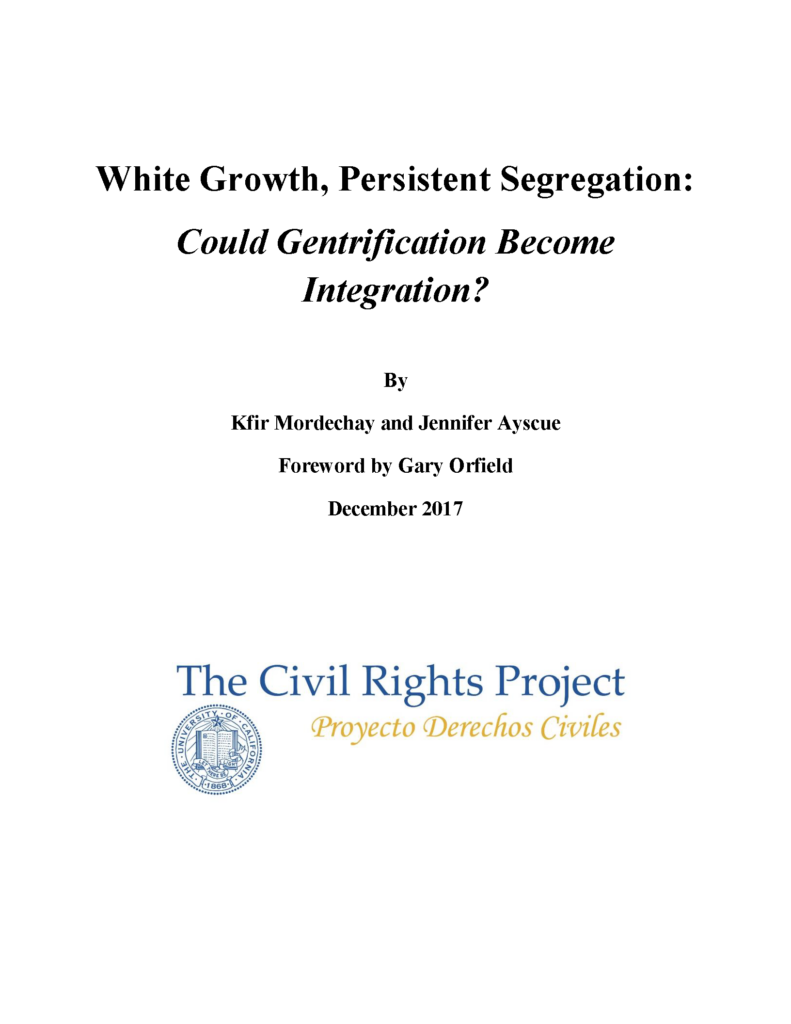Executive Summary
A major force in urban neighborhoods across the country, gentrification is also transforming the nation’s capital. In 2011, Washington, DC reached a non-black majority for the first time in more than a half century, and since 2000, the city’s white population has increased from just over a quarter to well over a third of the total population. This radical demographic transformation has deemed Washington, DC a “hotbed” of gentrification. Since gentrifying neighborhoods have the required residential integration to facilitate school integration, this report examines whether the potential educational and social benefits that could come from greater racial and socioeconomic diversity are being realized in the city’s most rapidly gentrifying neighborhoods.
Our analysis of neighborhoods and school enrollment patterns reveals that in Washington, DC’s most rapidly gentrifying areas, racial segregation has declined, more so in traditional public schools (TPS) than in charters. While this trend is promising, a high level of racial segregation remains, and substantial progress is still needed to ensure that these newly integrated neighborhoods also mean integrated schools.
Several major findings emerge:
- In the city’s most rapidly gentrifying census areas, the white population increased from approximately 5% in 2000 to just under 50% in 2015. During this same period, the white school enrollment in the same areas increased from 1% to 8%. As 17% of the school-aged population in the gentrifying areas is white, the asymmetry between neighborhood and school demographics cannot be explained by age alone. This finding likely suggests that a large share of white “gentrifier” parents are opting out of neighborhood schools.
- Between 2000 and 2014, a larger share of schools in gentrifying areas than in non-gentrifying areas experienced more extreme increases in the white share of enrollment. 12% of schools in gentrifying areas — but no schools in non-gentrifying areas — had more than a 50-percentage point increase in the white share of enrollment.
- Between 2000 and 2014, the black share of enrollment decreased while the Hispanic share almost doubled in schools located in both gentrifying and non-gentrifying areas. However, the black share of enrollment in gentrifying areas started higher in 2000 and remained higher in 2014 than in non-gentrifying neighborhoods. The reverse is true for Hispanics, as the Hispanic share of enrollment began lower in gentrifying neighborhoods in 2000 and remained lower in 2014 than in non-gentrifying neighborhoods.
- In 2014, over three-fourths of schools in gentrifying and non-gentrifying areas were intensely segregated, enrolling 90-100% non-white students. In 2014, a slightly larger share of schools in non-gentrifying areas (63%) than in gentrifying areas (55%) was hypersegregated, enrolling 99-100% non-white students.
- In both gentrifying and non-gentrifying areas, larger shares of charters than traditional public schools are majority minority, intensely segregated, and hypersegregated. In 2014, nearly three-fourths of charters were hypersegregated—71% of charters in non-gentrifying areas and 70% of charters in gentrifying areas. In non-gentrifying areas, 54% of traditional public schools were hypersegregated and in gentrifying areas, less than half (41%) were hypersegregated.
- While segregation persists at high levels in both charters and traditional public schools, segregation levels have declined substantially more in traditional public schools than in charters in gentrifying neighborhoods. Between 2007 and 2014, the share of hypersegregated TPS in gentrifying areas fell from 67% to 41%. During the same time, the share of hypersegregated charters in gentrifying areas declined more modestly from 77% to 70%.
Multiple coordinated and targeted policies could help manage gentrification such that it supports school integration. These recommendations underscore the deep and fundamental relationships among housing, communities, and schools:
- The federal government should prioritize the production of affordable housing and well-designed mixed-income developments.
- The preservation of existing affordable housing through rental assistance demonstrations, housing choice vouchers, and preservation-friendly incentives should be a major focus of local housing authority.
- Urban magnet programs with strategies and guidelines for racial and economic diversity should be used to create more integrated schools.
- Placing requirements for racial and economic diversity on charter schools in gentrifying areas also presents an opportunity for desegregation.
Gentrification is changing the demographic landscape of neighborhoods across the country and can potentially introduce social and financial capital to neighborhoods and urban school districts that previously lacked it. It is therefore essential that the gentrification process be managed to ensure that it creates inclusive communities and schools, rather than displacing low-income residents and residents of color.
In compliance with the UC Open Access Policy, this report has been made available on eScholarship:
